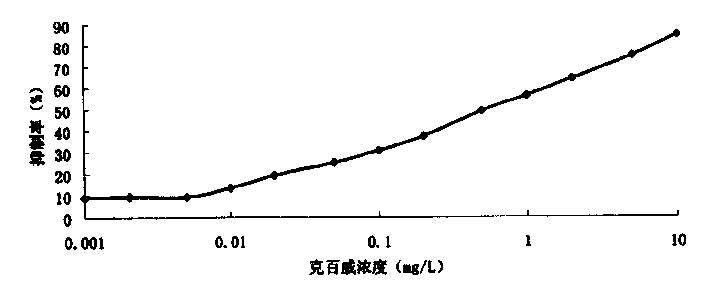Enzyme-linked immunosorbant assay kit applicable for carbofuran residue analysis
An enzyme-linked immunosorbent adsorption and residue analysis technology, applied in the direction of analytical materials, biological testing, measuring devices, etc., can solve the problems of cumbersome process, great influence on sensitivity, unsuitable for large-scale sample detection and analysis, etc., to improve sensitivity, The effect of simple pre-processing and less time-consuming
- Summary
- Abstract
- Description
- Claims
- Application Information
AI Technical Summary
Problems solved by technology
Method used
Image
Examples
Embodiment 1
[0011] The principle of determination is that first, the compound obtained by coupling the pesticide molecule with the macromolecular carrier (such as protein) is adsorbed on the solid-phase carrier as the coated antigen, and then the pesticide to be tested and the corresponding antibody are added, and the pesticide on the solid-phase antigen , the pesticide to be tested competes with the antibody. If the pesticide to be tested contains more, the antibody bound to the solid-phase antigen will be less. On the contrary, the antibody bound to the solid-phase antigen will be more. After the reaction, add an enzyme-labeled secondary antibody (which can only be combined with Combined with the antibody on the solid-phase antigen), and finally use the substrate for color development to determine. When the amount of antibody is constant, the more the amount of pesticide to be tested is added, the less the antibody combined with the solid-phase antigen, and the color reaction If it is we...
Embodiment 2
[0013] For the preparation of coated microtiter plates, the coated antigen (BFNB-OVA or BFNH-OVA) was coated with pH9.6, 0.05mol / L carbonate buffer solution (containing 1-2g sodium carbonate and 2-4g sodium bicarbonate, Double-distilled water (1 L) diluted to 0.1-1 μg / mL, add 100 μL to each well of the microtiter plate, coat overnight at 4°C or 2h at 37°C, pour off the coating solution, wash 3 times with PBST, and pat dry , and then add 150 μL of 1.0-3.0% skimmed milk powder to each well, put it in a 37°C incubator for 0.4-1 hour, wash with PBST three times, pat dry and store in a dry place. Example 3
Embodiment 3
[0014] Pretreatment of test samples:
[0015] Water sample: After filtration, samples can be taken for ELISA analysis.
[0016] Soil sample: Take 10g of soil and extract it three times with 20-40mL of methanol, combine the extracts, concentrate, then dilute with PBST to 10mL for ELISA analysis.
[0017] Vegetable samples: Take vegetable samples and crush them with a pulverizer, weigh 10g, extract three times with 20-40mL of methanol, combine the extracts, concentrate, dilute to 10mL with PBST, and take samples for ELISA analysis.
[0018] Blood: take human blood, add anticoagulant and directly analyze it by ELISA method.
[0019] Gastric lavage solution (2% sodium bicarbonate solution): take 10 mL of gastric lavage solution, adjust the pH value to neutral with dilute HCl, and then analyze it by ELISA.
[0020] Vomitus: Take the sample and grind it, centrifuge to get the supernatant and analyze it by ELISA method.
PUM
 Login to View More
Login to View More Abstract
Description
Claims
Application Information
 Login to View More
Login to View More - R&D
- Intellectual Property
- Life Sciences
- Materials
- Tech Scout
- Unparalleled Data Quality
- Higher Quality Content
- 60% Fewer Hallucinations
Browse by: Latest US Patents, China's latest patents, Technical Efficacy Thesaurus, Application Domain, Technology Topic, Popular Technical Reports.
© 2025 PatSnap. All rights reserved.Legal|Privacy policy|Modern Slavery Act Transparency Statement|Sitemap|About US| Contact US: help@patsnap.com


